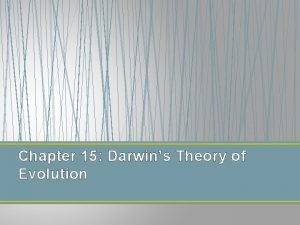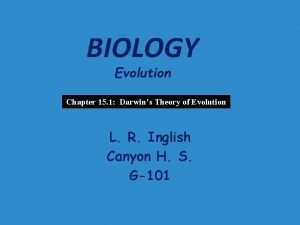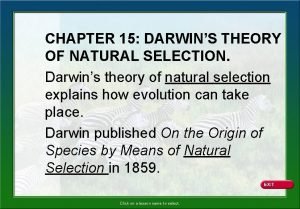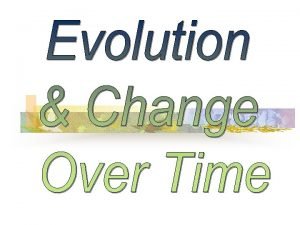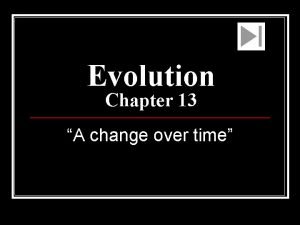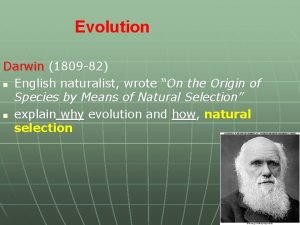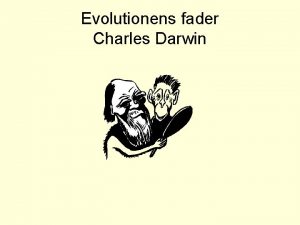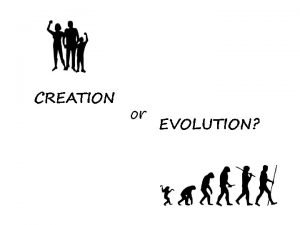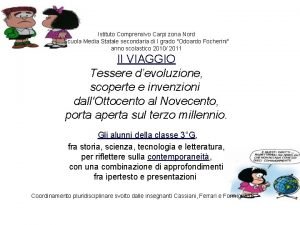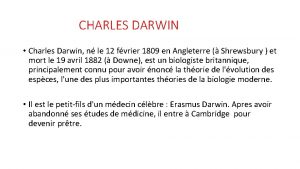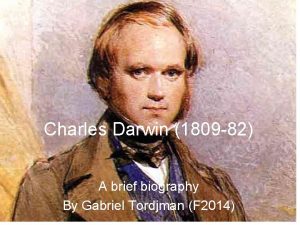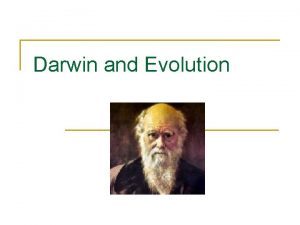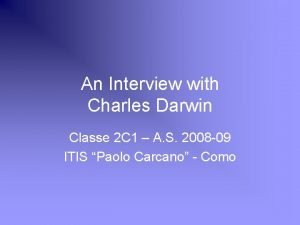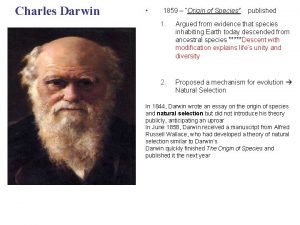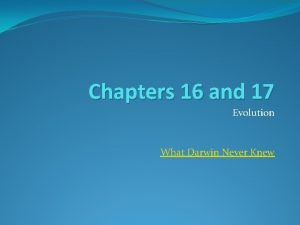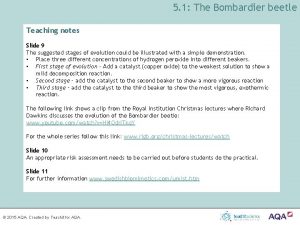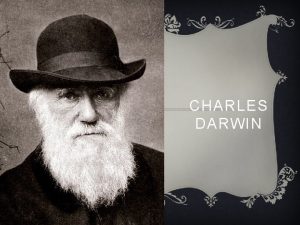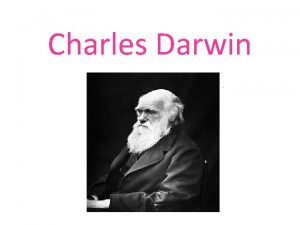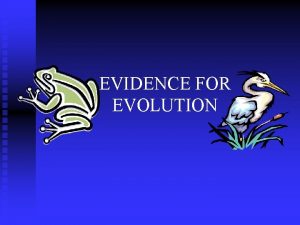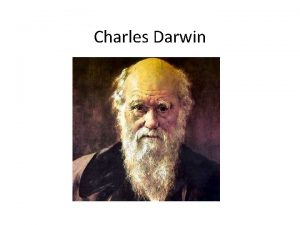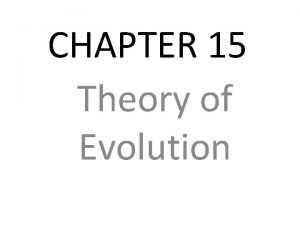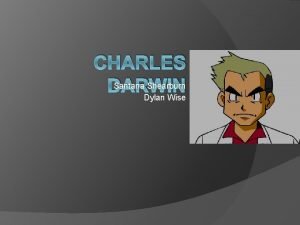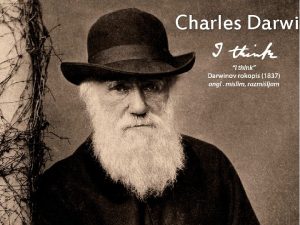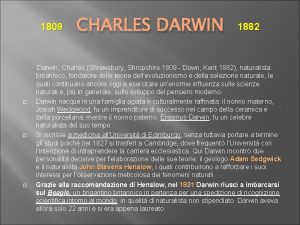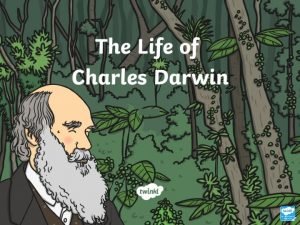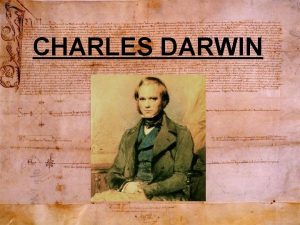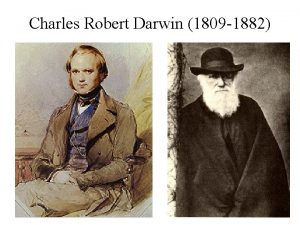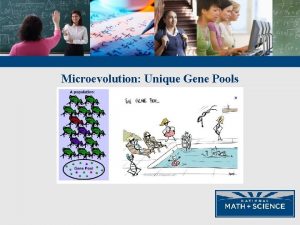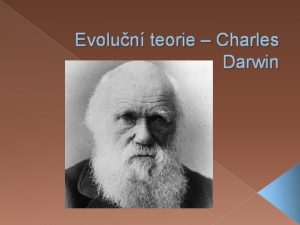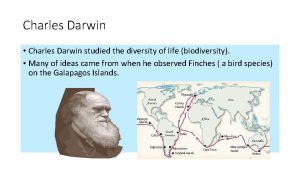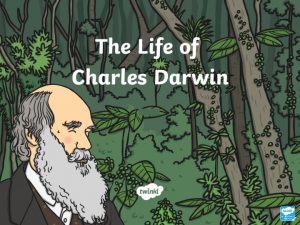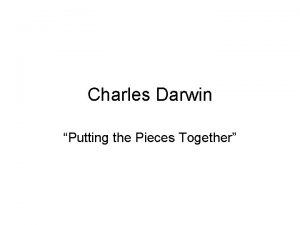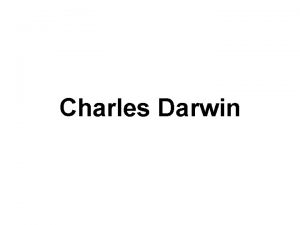CHAPTER 15 Theory of Evolution Charles Darwin Charles























- Slides: 23

CHAPTER 15 Theory of Evolution

Charles Darwin • Charles Robert Darwin • Born February 12 1809 – April 19 1882) • He was an English Naturalist. • In 1830 Darwin took a trip around the world on a ship called the HMS Beagle where he made many observations and went on to form one of the most important theories in biology.

The voyage of the Beagle • In December 1831, the British ship HMS Beagle set sail from England on a five year trip around the world. • Darwin was on board as a Naturalist • His job was to learn as much as possible about the living things he saw on the voyage.

Darwin’s Observations • Darwin made many observations along his stops on the Beagle • Darwin's observations included the diversity of living things, the remains of ancient organisms, and the characteristics of organisms on the Galapagos Islands. Darwin was amazed by the tremendous diversity of living things. Scientists now have identified more than 1. 7 million species of organisms.

The Galapagos Islands • In 1835 the Beagle reached the Galapagos Islands, where Darwin observed many unusual life forms on these small islands such as giant tortoises and giant iguanas. • When Darwin returned to England, he compared organisms to organisms that lived elsewhere. He also compared organisms on different islands in the Galapagos group. • He was surprised by some of the similarities and differences he saw.

• Darwin found many similarities between Galapagos organisms and those in South America. However, there were important differences. • The Iguanas on the Islands had large claws that allowed them to grip slippery rocks while the iguanas on the mainland had smaller claws to climb trees. • Darwin was also fascinated in particular by the land tortoises in the Galápagos. • Giant tortoises varied in predictable ways from one island to another. • The shape of a tortoise's shell could be used to identify which island a particular tortoise inhabited.

Adaptations • Like the tortoises, the finches on the Galapagos Islands were noticeably different from one island to the next. • The most obvious difference on the Finches was their beak size and shape. • Darwin proposed that each species of finch had a different size and shaped beak to suit its environment. This is an example of an Adaptation. • An Adaptation is a trait that helps an organism survive and reproduce.


Evolution • Darwin wanted to understand the different adaptations of organisms on the Galapagos Islands. • He hypothesized that the species gradually changed over many generations and became better adapted to the new conditions. • The gradual change in species over time is called EVOLUTION.

Lamarck’s Ideas on Evolution • French biologist jean Baptiste Lamarck (17741829) also supported the idea that species change over time but proposed a different way to explain HOW evolution happens. • Lamarck proposed that individuals could acquire traits during their lifetime as a result of experience or behavior, then could pass on those traits to offspring. Lamarck called this idea: the inheritance of acquired characteristics. • This idea is no longer accepted by scientists


Descent with modification • Darwin used the phrase descent with modification to describe the process of evolution. • Descent with Modification-Each living organism has descended, with changes from other species over time • Common Descent- were derived from common ancestors • Ex: Darwin's finches

Natural Selection • In 1858, Darwin and Alfred Russell Wallace, each proposed an explanation for how evolution could occur in nature. • Darwin proposed that evolution could happen by natural selection. • Natural selection is the process by which individuals that are better adapted to their environment are more likely to survive and reproduce than other members of the same species.

Darwin identified factors that affect Natural Selection: • 1. Overproduction: Most species produce many more offspring that can possible survive. • 2. Genetic Variations: any difference between individuals of the same species. • 3. Struggle to survive: because resources are limited, members of a species must compete with each other to survive.

• 4. Selection: Darwin proposed that over a long time, natural selection can lead to change. Helpful variations may gradually accumulate in a species while the unfavorable ones disappear. • Over time, natural selection results in changes in inherited characteristics of a population. These changes increase a species fitness in its environment

Evidence of Evolution • The Fossil Record • Geographic Distribution of Living Things • Homologous Body Structures • Similarities in Early Development

Evidence for Evolution: • The Fossil Record. Layers show change * Different organisms lived at different times * Species have differed in a gradual sequence of forms over time (transitional species)

Evidence for Evolution • Vestigial organs-organs that serve no useful function in an organism • i. e. ) appendix, miniature legs, arms

Evidence for evolution: Biogeography • Geographic Distribution of Living Thingssimilar environments have similar types of organisms * The model of Descent with modification provides an explanation for these patterns of distribution.

ANATOMY & EMBYOLOGY • Homologous Structures-structures that have different mature forms in different organisms, but develop from the same embryonic tissue. (similar in structure and function AND have a common ancestry in evolution) • Analogous structures- closely related function but do not derive from the same ancestral structure. (similar function but have a different evolutionary origin)


Similarities in Early Development

Convergent & divergent Evolution • Convergent evolution is the process by which unrelated or distantly related organisms evolve similar body forms, coloration, organs, and adaptations. Wxample: Convergent evol: WINGS of insects, birds and bats. (thes are also called analogous structures). • Divergent evolution occurs when a group from a specific population develops into a new species. In order to adapt to various environmental conditions, the two groups develop into distinct species due to differences in the demands driven by the environmental circumstances. Adaptive radiation is a process in which one species gives rise to multiple species that exploit different niches in the environment. The ecological niches exert the selection pressures that push the populations in various directions. On the various Galapagos islands, finch species have become adapted for different diets: seeds, insects, flowers, the blood of seabirds, and leaves. Divergent evol: Wings of a bat, the humam forearm and fingers, the flipper of a whale , wing of a bird , foreleg of horse. These are also known as homologous structures.
 Explain the theory of evolution
Explain the theory of evolution Chapter 15 darwin's theory of evolution section 15-1
Chapter 15 darwin's theory of evolution section 15-1 Www.bf.tku.edu.tw/files/news chapter 17
Www.bf.tku.edu.tw/files/news chapter 17 Chapter 15 darwin's theory of evolution section review 15-1
Chapter 15 darwin's theory of evolution section review 15-1 Chapter 15 darwin's theory of evolution section review 15-1
Chapter 15 darwin's theory of evolution section review 15-1 Natural selection
Natural selection What does darwin's theory of evolution suggest?
What does darwin's theory of evolution suggest? Darwin's theory of evolution
Darwin's theory of evolution H
H Vem var charles darwin
Vem var charles darwin Where was charles darwin born
Where was charles darwin born Where was charles darwin born
Where was charles darwin born Famous people with linguistic intelligence
Famous people with linguistic intelligence Charles darwin origine della specie
Charles darwin origine della specie Giustificazione dello schiavismo versione greco
Giustificazione dello schiavismo versione greco Charles darwin vikidia
Charles darwin vikidia Where was charles darwin born
Where was charles darwin born Charles darwin notes
Charles darwin notes Chronemics communication definition
Chronemics communication definition Charles darwin
Charles darwin Charles darwin
Charles darwin Charles darwin
Charles darwin Charles darwin
Charles darwin Bombardier beetle darwin
Bombardier beetle darwin



